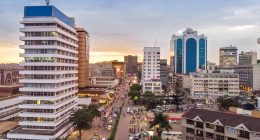Ahead of their adoption by UN member states in September last year, UN Secretary General Ban Ki Moon hailed the new set of global development goals – the Sustainable Development Goals (SDGs) – as “the people’s agenda, a plan of action for ending poverty in all its dimensions, irreversibly, everywhere, and leaving no one behind!”
At the heart of these goals is the acknowledgement that whereas economic growth and development are important, their sustainability will depend on how far they are able to address the needs of, and provide opportunities for everybody, including the ‘base of the pyramid’ — the large number of poor people in a given developing country.
In particular, Goal Number 8- Promoting inclusive economic growth & decent employment for all by 2030, calls upon member countries to prioritize high-value added and labour-intensive sectors and adopt development-oriented policies that support entrepreneurship, creativity and innovation, and encourage the formalization and growth of micro-, small- and medium-sized enterprises, to be able to absorb their vast young population in meaningful employment.
Globally, whereas economic growth has been undeniable, so has poverty and inequality. Over the last half of a century, the gap between the rich and the poor has steadily widened, so much that the average income of the richest 10% of the population is about nine times that of the poorest 10% across the OECD countries, for example. Nowhere has this mismatch has been more evident than in developing countries, most of them in Africa.
Over the last half of a century, the gap between the rich and the poor has steadily widened, so much that the average income of the richest 10% of the population is about nine times that of the poorest 10% across the OECD countries, for example
Although the continent has registered impressive growth over the last two decades, averaging double digits in some countries, for a significant number of Africans, this growth has been inequitable, exclusive and with little progress as regards job creation. The International Labour Organization classifies 82 percent of African workers as poor, because they are stuck into the informal sector of self-employment and lack good wage-paying jobs. The situation is even direr for the continent’s youth, who despite constituting more than half of the population, also make up 60% of the continent’s unemployed, according to the World Bank.
Scholars have long warned about the danger posed by such large unemployed youth populations. The Arab Spring, which toppled long-serving regimes in Tunisia, Egypt and Libya, was partly conditioned by lack of employment opportunities for young people. More worryingly, a World Bank survey in 2011 showed that about 40% of those who join rebel movements say they are motivated by a lack of jobs.
Although the East African region has registered impressive growth over the last two decades, averaging 7-8 percent in some countries, for a significant number of East Africans, this growth has been inequitable, exclusive and with little progress as regards job creation.
According to the 2013 State of East Africa Report, just 1.6% of Uganda’s youth, 4% of Burundi’s, 5% of Tanzania’s and 6% of Kenya’s working populations are formally employed; and young East Africans working in the informal sector have a higher probability of being paid below the minimum wage or the poverty line.
Foreign direct investment in the region has grown by nearly 20% in the last decade, the strongest in Africa. On the back of this goodwill, regional infrastructural initiatives like the Northern and Central Corridor projects can be utilized to create employment and business opportunities for the region’s burgeoning youth population. However, there is still lack of a more proactive government attitude towards SMEs and prudential regulation of the sector. This has affected expansion of the sector and growth of these SMEs into bigger companies so they can provide space for smaller companies and startups to create basic jobs.
A 2012 survey by the African Development Bank across East Africa revealed that the banking sector in the region found that banks were eager to do business with small and medium-sized enterprises (SMEs) – which sector provides up to 60% of jobs in the formal sector – in the region. On average 37% of loans given out by banks in Uganda, Kenya and Tanzania go to SMEs.
We must insist on strategic actions and ways to stem the growing income inequality that is threatening regional security and stability. This will require close working relationships between policy makers, private sector players and development partners to adopt combined efforts. At the cote of the strategic actions is to create more economic opportunities for young people and utilizing the region’s expected “youth bulge” to spur economic growth and yield a demographic dividend for East Africa.







